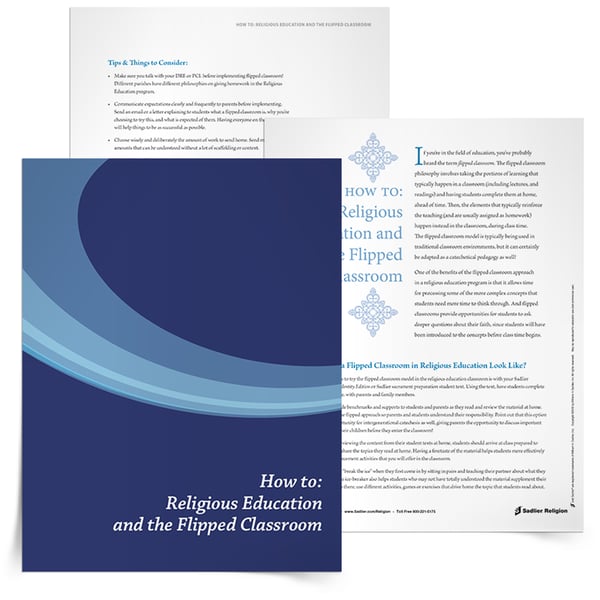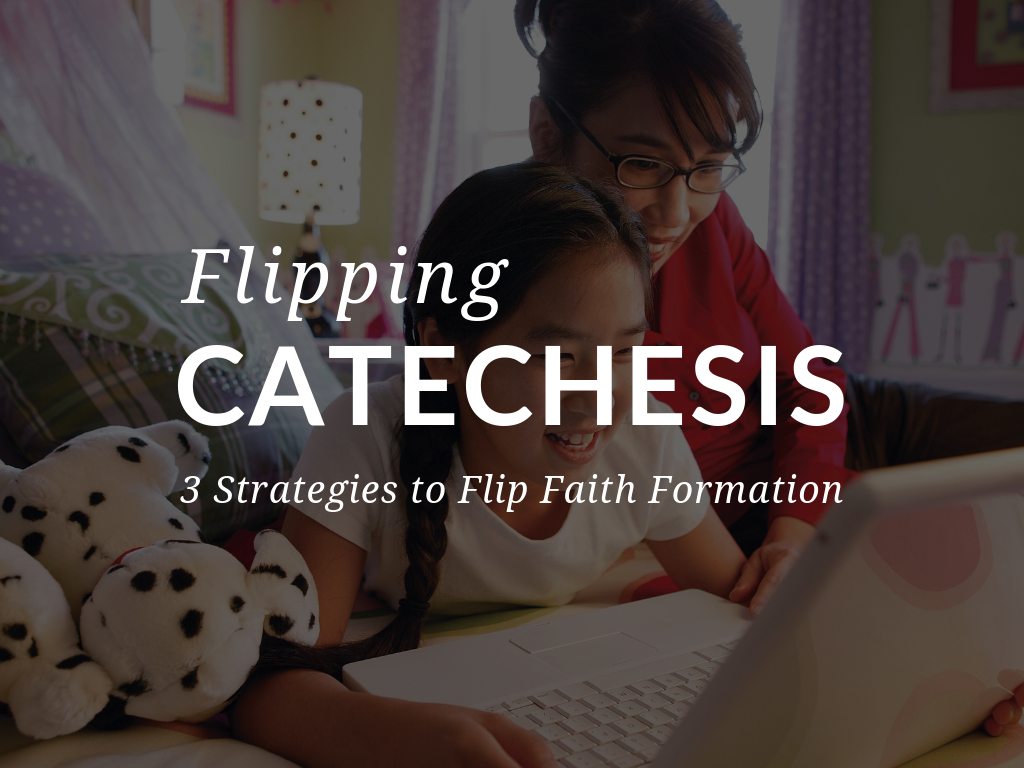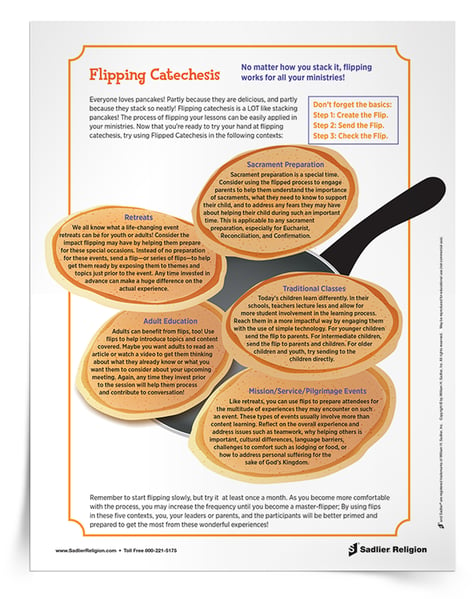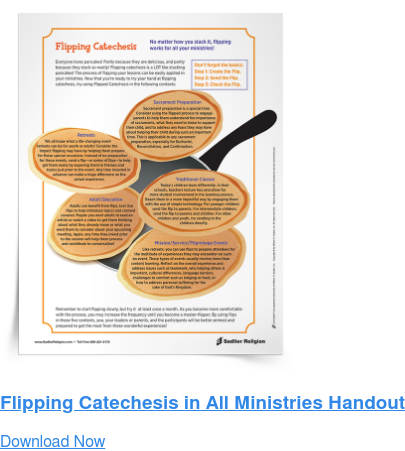March 12, 2019 REL Catechetical - K–6, REL Catechetical - Jr High, REL Topic - Catechesis, REL Asset - eBook, REL Asset - Handout, REL PD - Catechist, REL PD - Leaders, REL Topic - Methodology
Sadlier's Director of Digital Catechesis, Steve Botsford, MBA, MRE, shares how Flipped Catechesis can address three serious challenges facing today's catechist. Plus, learn how to create, share, and evaluate a flipped catechetical lesson in a FREE 3-part online Masterclass. Register for the ON DEMAND Masterclass now!
Download a Flipping Catechesis in All Ministries Handout now!
Challenges Facing Catechesis Today
Catechesis is one of the most important missions within the Church. Catechists support parents in their role as primary educators of the faith. Catechists serve as banquet hosts by introducing children to Jesus and the Catholic faith and share something with children that is truly eternal. So, in what ways can catechesis be challenging?
Have you recently taught a religious education class and noticed kids don’t behave like you used to behave in religious education class? I remember when behavior was a big deal, when your posture had to be upright and your attention focused on the catechist. Or, have you taught a wonderful lesson and just as you were getting to the children’s activity and noticed you’re out of time? Or, perhaps you sent home copies of a family worksheet only to find many of them on the floor in the hallway—or worse—stuffed in trash cans. These experiences, which are actual examples from my own experience as a volunteer catechist, bring to light three serious challenges facing today’s catechist: engagement, time, and parental involvement.
1. Kids Aren’t Engaged
Today’s kids learn differently. It is rare that students sit all day, listening to lectures and completing handouts in silence. Learning today is much more active, engaging, and loud! Kids are more involved in classroom decisions and are used to teamwork, many times completing projects in collaborative pairs or groups. With the availability of computers, today’s students expect some sort of technology use in their learning and processing. When we notice different behavior in more traditional, technology-less religion education sessions, it begs the question: are today’s students disrespectful, or just disengaged?
2. Sessions Aren’t Long Enough
Even if catechists can provide enough engagement to keep students interested, there never seems to be enough time for all there is to do to complete a lesson. We must introduce the topic and have students reflect on what they already know and want to learn, pray, teach the concepts and terminology associated with the lesson, conduct an activity, pray again, and do our best to get parents involved. In my experience, by the time you get the teaching done, it’s time to wrap it up for the day. How is it possible to maximize the time we have, or find more time?
3. Parents Aren’t Involved
Many parish catechetical leaders that I have spoken with express that parent involvement in the faith formation of their child is at an all-time low. We applaud those parents who have a desire to support their child in faith formation but realize there are many roadblocks to making this happen! If family handouts are left behind after religious education classes, how are we to reach families and partner with parents?
Address These Challenges With A Modern Solution
There is a solution to these challenges, and it’s called Flipped Catechesis! Flipped Catechesis is an approach that uses a simple way of reaching learners and parents before the next lesson, gets them to complete an online communication, and then helps catechists know exactly what to talk about during the session.
Flipped Catechesis
Flipped Catechesis originates from academic approaches in which what is typically done during the lesson is done prior to the lesson. For example, reviewing or teaching new concepts can moved (flipped) to before the lesson. This frees up lesson time for students to ask questions, explore more with hands on activities, and to explore concepts in more depth.
If teachers “flip” the process, they have more class time to help students truly understand the concepts. What I discovered is that this approach can be effectively used for faith formation, too!
By flipping catechesis, we are able to address the concerns of kids’ lack of engagement, maximize session time, and get parents involved! So, how does it work?
For a bit more background information about a flipped approach to religious education, check out the How To: Religious Education and the Flipped Classroom eBook.

Flipping Catechesis in Three Steps
Flipping catechesis can be accomplished in three easy steps. You will create a flip, send the flip, and check your student’s responses. Let’s take a closer look!
Step 1: Create the Flip
Creating a flipped lesson is an easy process, and one that, once created, can be duplicated. The flip is an online form that includes a short video, three student questions, and one parent question. The idea is that the student or parent receives the flip just prior to the session. They complete it and the catechist receives the responses.
Step 2: Send the Flip
Once the flip has been created, it must be sent to the parent or child. This can take place through a variety of digital communication services from email, to text, or push notifications.
Step 3: Check the Flip
Once the flip has been completed by the parent or child, the responses are available for the catechist to view. Responses from each respondent can be viewed online so catechists know how parents or children answered. Catechists can easily adjust instruction to maximize session time with the information.
Reaping the Benefits of Flipped Catechesis
Still not convinced? While flipping catechesis is a simple process that imposes little on the catechist, but it has had a major impact in my role as a catechist. In using this process for several years, I have witnessed a consistently high percentage of students who complete the flip. Parental involvement has increased, and session times have become more student-centered with opportunities for teamwork and presentations. Wouldn’t you like to experience some of these benefits, too?
Engage Kids Before the Lesson
With a high percentage of students completing the flip before our sessions, they are able to consider the session topic, reflect on what they already know about the topic, and ask any questions that may remain.
Involve Parents
Since parents are the primary educators of their children, Flipping Catechesis enables catechists to support faith development in the home. Parents are participating in what is being taught to their child by completing the parent question in the flip. Flipping opens conversations and fosters a deeper sense of family.
Tweak Instruction
By using flipped catechesis, I have been able to understand what my students know and understand, what questions they have, and tweak my teaching based on their responses. It saves time because I may not need to teach everything in the text if they already understand it, and I can spend more time highlighting what they have questions about.
Get Started!
What are you waiting for? Now that you have learned about my 3-step flipping catechesis process, why not give it a try? Download a guide for using flipped catechesis in various contexts, such as for traditional classes, sacrament preparation, retreats, adult education, and more!
Advance Your Learning So You Can Get Started!
Now that you’ve learned about the benefits of a flipped catechesis approach, learn how to put it into action in your own program with our flipped catechesis expert, Steve Botsford. Register for Steve’s FREE 3-part online Masterclass. Here's what you'll learn:
Class 1: Creating Engaging Flipped Catechetical Learning Experiences-
Learn how to create a flipped lesson for students to complete at home, on their own, or with their families, to begin learning the content of the next lesson.
Class 2: Strategies to Send the Flipped Lesson Home
-
Discover strategies for sending the flipped lesson home at a time that maximizes student and family participation.
Class 3: Checking Understanding to Adjust Instruction
-
Finally, to more efficiently personalize your lesson plan, learn how to assess what students understand about topics.








